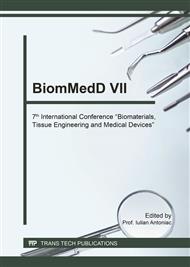[1]
M.S. Duggal, M.E.J. Curzon, S.A. Fayle, K.J. Toynba, A.J. Robertson, Restorative Techniques in Paediatric Dentistry: An Illustrated Guide to the Restoration of Extensive Carious Primary Teeth, CRC Press, New York, (2002).
DOI: 10.1201/b14692
Google Scholar
[2]
M. Rosa, B.U. Zachrisson, The space-closure alternative for missing maxillary lateral incisors: an update, J Clin Orthod 44-9 (2010) 540-549.
Google Scholar
[3]
I. Antoniac, C. Sinescu, A. Antoniac, Adhesion aspects in biomaterials and medical devices, J Adhes Sci Technol, 30-16 (2016) 1711-1715.
Google Scholar
[4]
V. Jain, G. Pruthi, K. Mundhe, Clinical considerations for prosthodontic rehabilitation of intermediate form of osteopetrosis: A report of two cases, Journal of oral biology & craniofacial research, 2-2 (2012) 126-130.
DOI: 10.1016/j.jobcr.2012.05.008
Google Scholar
[5]
C.M. Coelho Filho, Clinical application of the mandibular protraction appliance in upper lateral agenesy and in asymmetric cases, Tex Dent J, 119-7 (2002) 618-626.
Google Scholar
[6]
B. Mummidi, C.H. Rao, A.L. Prasanna, M. Vijay, K.V. Reddy, M. Raju, Esthetic dentistry in patients with bilateral missing maxillary lateral incisors: a multidisciplinary case report, J Contemp Dent Pract. 14-2 (2013) 348-354.
DOI: 10.5005/jp-journals-10024-1326
Google Scholar
[7]
T. Nguyen, Orthodontic treatment of a congenitally missing maxillary lateral incisor, J Esthet Restor Dent. 22-5 (2010) 313-314.
DOI: 10.1111/j.1708-8240.2010.00357.x
Google Scholar
[8]
R.R. Almeida, A.C. Morandini, R.R. Almeida-Pedrin, M.R. Almeida, R.C. Castro, N.M. Insabralde, A multidisciplinary treatment of congenitally missing maxillary lateral incisors: a 14-year follow-up case report, J Appl Oral Sci. 22-5 (2014) 465-471.
DOI: 10.1590/1678-775720140061
Google Scholar
[9]
R.G. Alexander, Space closure in patients with missing mandibular incisors, J Clinic Orthod 42-8 (2008) 467-473.
Google Scholar
[10]
Patricia Fernanda Dias, Lizandra Ferrari Guimarães , Ana Lúcia de Souza Freire Sanchez , Laura Guimarães Primo, Rehabilitation of a Child with History of Multiple Natal Teeth and Oligodontia in the Permanent Dentition, Rev. Fac. Odontol. Porto Alegre, 50-2 (2009).
DOI: 10.22456/2177-0018.9162
Google Scholar
[11]
Flavia Riqueto Gambareli, Marcia Diaz Serra, Maria Beatriz Duarte Gaviao, Effect of removable partial denture replacing primary molars on mastication of foods with variable texture, Journal of texture study, 40-2 (2009) 240-255.
DOI: 10.1111/j.1745-4603.2009.00179.x
Google Scholar
[12]
R. Welbury, M. Duggal, M. Hosey, Paediatric dentistry, Oxford University Press, London, (2012).
Google Scholar
[13]
I. Antoniac, Biologically responsive biomaterials for tissue engineering, Springer-Verlag, New York, (2013).
Google Scholar
[14]
I.V. Antoniac, Handbook of Bioceramics and Biocomposites, Springer, New York, (2016).
Google Scholar
[15]
R Silva Meza, Radiographic assessment of congenitally missing teeth in orthodontic patients, International Journal of Paediatric Dentistry 13-2 (2003) 112-116.
DOI: 10.1046/j.1365-263x.2003.00436.x
Google Scholar


